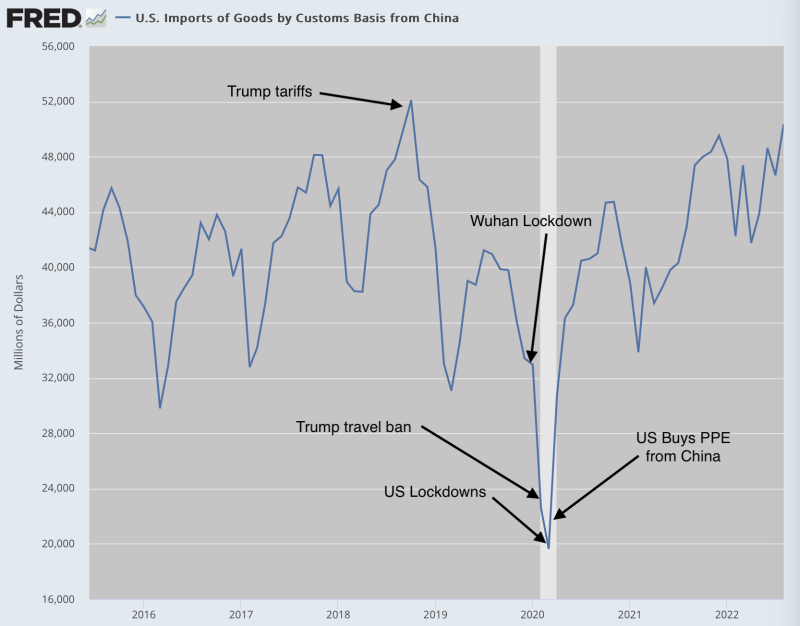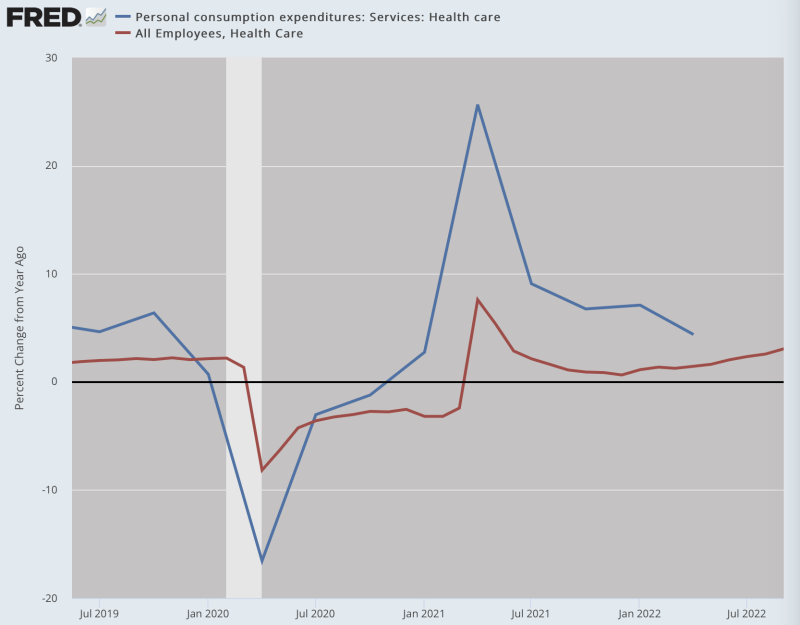Starting in 2018, President Trump imposed tariffs on trade with China. It was an unusual approach by any postwar standard. Normally presidents past would impose tariffs on goods from any country in the name of protecting domestic industry, or perhaps target a single country on grounds of national security.
This was different – targeting a single country on economic grounds – and it happened because Trump had a list of countries with whom the US ran a trade deficit, which he saw as proof of how “they” owed “us” money.
So he started at the top of the list (China) and went down (Mexico, Germany, and even Canada). There is no evidence that he fully understood either what it means to have a “trade deficit” or that these policies could not force any other country to pay anything; American consumers and businesses pay the tariffs as another form of taxation to the US government.
In any case, contrary to what Trump promised and expected, Xi Jinping retaliated and made it ever more difficult for the US to export to or import from China. Consumers and producers on both sides suffered. For a while, the consequences for China were devastating. By October 2018, imports from China to the US fell off a cliff.
Matters became far worse with pandemic lockdowns in the US, a period during which China had opened up completely. Trump shut down travel to China on January 31, 2020, thinking that this would keep the virus out that had been in the US already six months, and continually referred to the “China virus.” A pathogen from China was something that Trump believed he needed to stop. The result was another blow to US-China trade.
Anthony Fauci’s deputy assistant H. Clifford Lane went to China in mid-February 2020 to observe how China had supposed crushed the virus through brutal lockdowns, and, through a WHO report, urged the US to follow the same course. Trump went along at the urging of Fauci, Deborah Birx, and his son-in-law Jared Kushner, as well as vice president Mike Pence.
That was the end of US/China trade. But not for long. It quickly recovered and now is back to what it was in dollar terms. This is largely because the US started buying billions (we don’t know how much exactly but someone should find out) in personal protective equipment (masks, gloves, gowns, plus swabs and everything) from China in March just after lockdowns began.
This began a major recovery in US/China trade.
Here is the graph and it shows all the above in terms of US imports from China.

You undoubtedly noticed this during the pandemic. Most of the masks and other things related to equipment came from China. That’s pretty interesting, don’t you think? How the heck did this happen? Trump’s priority of “decoupling” the two countries ended up doing the opposite, at least for a time. Fascinating.
Jared Kushner tells his side of the story in his book Breaking History.
The system we established at FEMA unleashed a global procurement effort not seen since World War II. Boehler, Smith, and the FEMA team leaped into action, calling every major medical supplier around the globe in a race to purchase millions of masks, gowns, gloves, testing swabs, and other critical supplies. As we sourced supplies from all over the world, we discovered that the factories with the most available supplies were in China. Despite their abundance of product, the Chinese government was blocking supplies from leaving the country. I knew that in time Americans would be able to manufacture much of what we needed, but at this moment we had no time to spare.
We needed to ask the Chinese government if they would allow us to purchase supplies, which meant that we needed to address the growing tension between our two governments. As the coronavirus grew from a localized problem in Wuhan into a global pandemic, the president’s rhetoric toward China had grown increasingly antagonistic….
What to do? Kushner needed to persuade Trump to relax his attitude toward China trade. That would take some doing.
I went to speak with Trump privately.
“We’re scrambling to find supplies all over the world,” I told him. “Right now, we have enough to get through the next week—maybe two—but after that it could get really ugly really fast. The only way to solve the immediate problem is to get the supplies from China. Would you be willing to speak to President Xi to deescalate the situation?”
“Now is not a time to be proud,” said Trump. “I hate that we are in this position, but let’s set it up.”
I reached out to Chinese ambassador Cui Tiankai and proposed that the two leaders talk. Cui was keen on the idea, and we made it happen. When they spoke, Xi was quick to describe the steps China had taken to mitigate the virus. Then he expressed concern over Trump referring to COVID-19 as the “China Virus.”
Trump agreed to refrain from calling it that for the time being if Xi would give the United States priority over others to ship supplies out of China. Xi promised to cooperate. From that point forward, whenever I called Ambassador Cui with a problem, he sorted it out immediately.
So there we go: just after US lockdowns, Trump called Xi and Xi told Trump again how great lockdowns were and asked that Trump stop blaming China. Trump agreed to stop the rhetoric and stop claiming the virus was China’s fault. Trade was on again, in the midst of what Trump was told was an emergency. He had already green-lighted a China-style virus mitigation effort. Now he was restarting trade.
Some of the factories making this stuff in China were American factories, particularly one owned by 3M, an American company that had long outsourced its manufacturing to China. Trump called the CEO and asked for their PPE but the management demurred and said China would not allow it. Trump invoked the rarely used Defense Production Act (1950) and said that now 3M had to sell supplies.
Kushner continues the story:
Later, I called [Mike] Roman [3M CEO) and told him that we were sending him a contract for all of 3M’s masks in China.
“I can’t sell them to you,” he said. “The Chinese government has taken over my factory and is controlling my distribution.”
“That’s not your problem anymore,” I said. “It’s our problem. Under the DPA, we technically control your company. We’re going to send you a contract, and federal law requires you to sign it. You can tell the Chinese that you had no choice.”
Within thirty minutes, Roman signed the contract and the masks were ours. Now I had to work with the Chinese to get the masks to America.
Kushner doesn’t say what the contract was worth or how many tax dollars were fed to the US company with manufacturing operations in China. But he does say how many masks the US bought: forty-six million masks per month for the next six months.
And the final note:
Once Roman saw that we had used diplomacy to work out the situation with the Chinese government, and that we weren’t looking to take the rest of his global supply, he became much more agreeable. In the end, he and 3M became great partners in our effort.
Looking back, it’s unclear whether and to what extent there really was any crisis at all beyond the hothouse frenzies generated in political circles. In this way, the PPE shortage was like the supposed ventilator shortage: speculations that drove frenzied solutions that ended up looking for a problem to solve. In the case of ventilators, they ended up using them and killing thousands of people. Masks, as we know, ended up being used everywhere but nowhere produced solid evidence of disease mitigation.
Because hospitals around the country were shut to most uses but Covid patients, by government edict, parking lots stood empty and nurses in hundreds of hospitals were furloughed. Not even the idea of overwhelmed New York City hospitals holds up to scrutiny. In the early months, the number of employees working in health care fell by 1.8 million while health care spending crash by 16.5 percent. Historians will surely be very confused how this could have happened in the midst of a pandemic.

There is a strange way in which US lockdowns and disease panic miraculously healed the US/China trade rift that had been developing for the two years prior. Most “personal protective equipment” and especially masks used during the lockdown period in the US was imported from China in a deal between Trump and Xi, brokered by Trump’s son-in-law. Trade recovered, beginning with pandemic-related goods.
Following the installation of Biden as president, every American was forced to wear China-made clothing on their faces.
